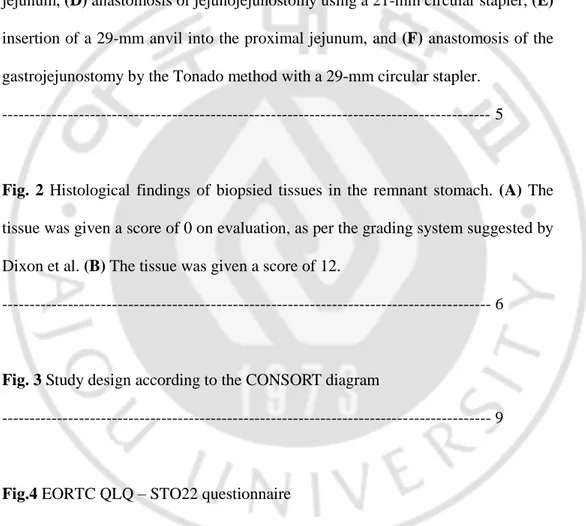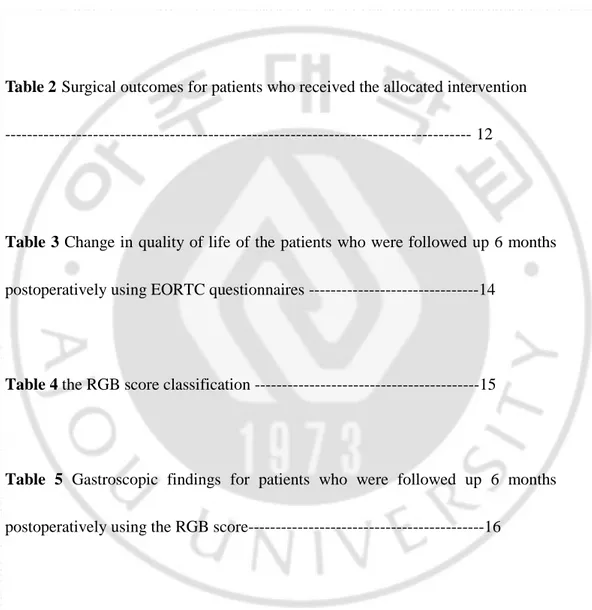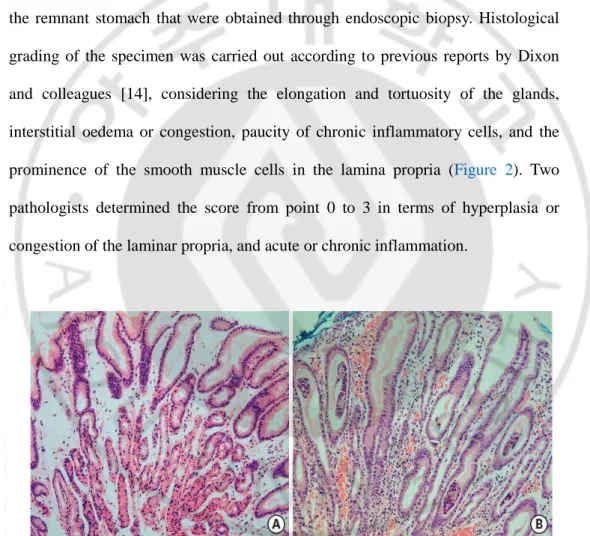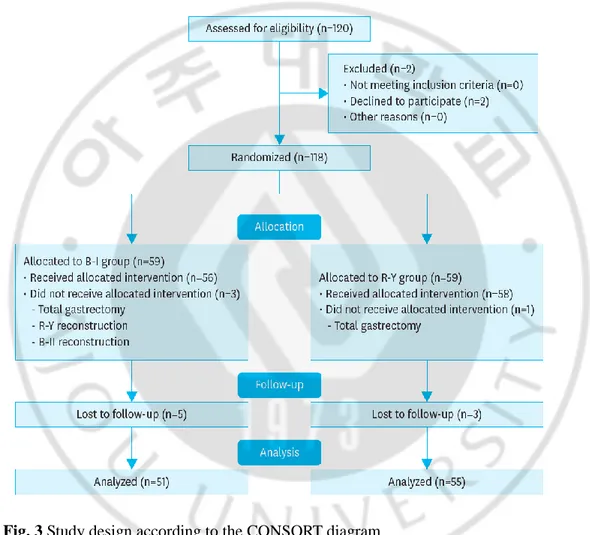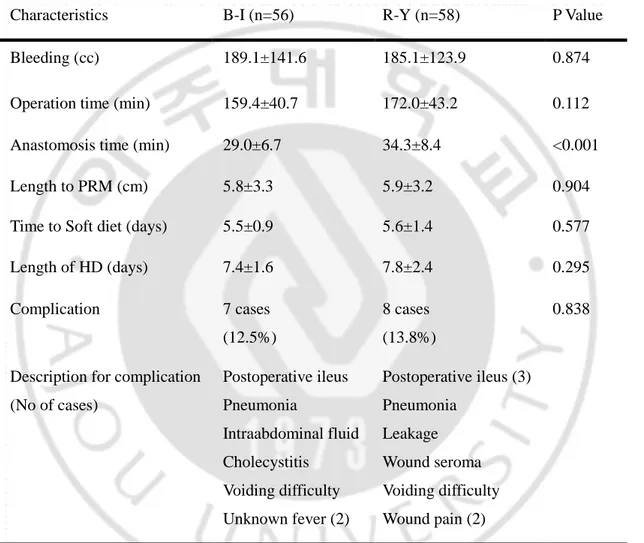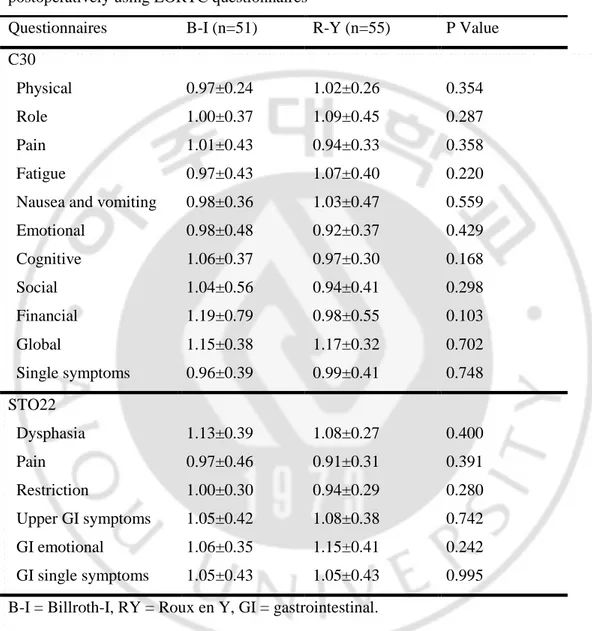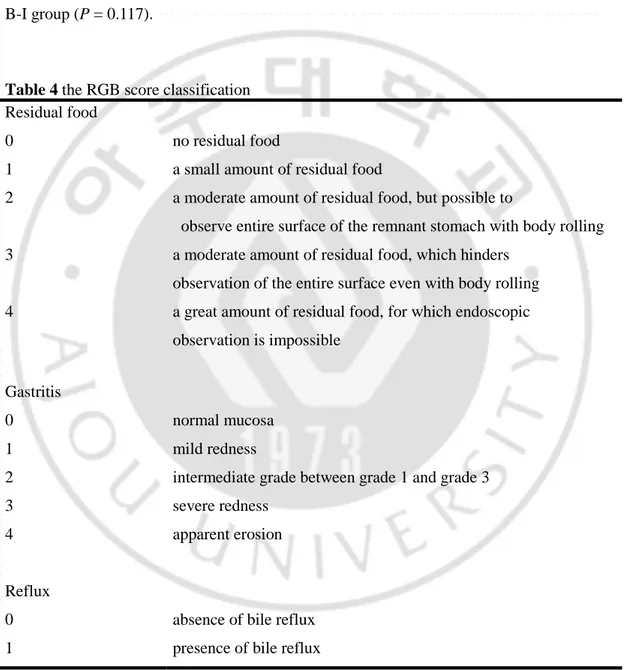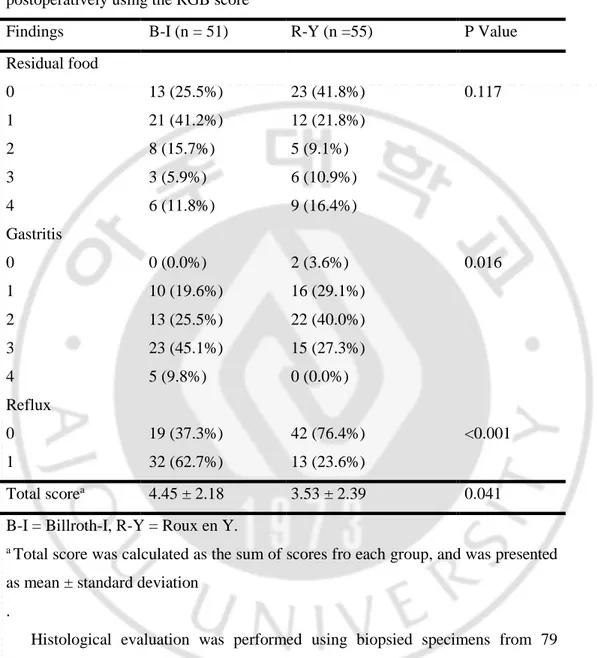저작자표시-비영리-변경금지 2.0 대한민국 이용자는 아래의 조건을 따르는 경우에 한하여 자유롭게 l 이 저작물을 복제, 배포, 전송, 전시, 공연 및 방송할 수 있습니다. 다음과 같은 조건을 따라야 합니다: l 귀하는, 이 저작물의 재이용이나 배포의 경우, 이 저작물에 적용된 이용허락조건 을 명확하게 나타내어야 합니다. l 저작권자로부터 별도의 허가를 받으면 이러한 조건들은 적용되지 않습니다. 저작권법에 따른 이용자의 권리는 위의 내용에 의하여 영향을 받지 않습니다. 이것은 이용허락규약(Legal Code)을 이해하기 쉽게 요약한 것입니다. Disclaimer 저작자표시. 귀하는 원저작자를 표시하여야 합니다. 비영리. 귀하는 이 저작물을 영리 목적으로 이용할 수 없습니다. 변경금지. 귀하는 이 저작물을 개작, 변형 또는 가공할 수 없습니다.
A Novel Roux-en-Y
reconstruction involving the use of two
circular staplers after distal subtotal
gastrectomy for gastric cancer
Graduate School of Ajou University
Department of medicine
Chang Wook Ahn
A Novel Roux-en-Y
reconstruction involving the use of two
circular staplers after distal subtotal
gastrectomy for gastric cancer
Sang-Uk Han, M.D., Ph.D., Advisor
I submit this thesis as the
Doctoral thesis in medicine.
August
2019
Graduate School of Ajou University
Department of
medicine
The Doctoral thesis of Chang Wook Ahn in medicine is
hereby approved.
Thesis Defense Committee Chair
김욱환 Seal
Member 한상욱 Seal
Member 이광재 Seal
Member 허훈 Seal
Member 진형민 Seal
Graduate School of Ajou University
Authors contributions
Conceiving and designing the study: Hoon Hur, Sang-Uk Han
Collecting the data: Chang Wook Ahn, Cheul Su Byun, Ho Jung Shin Analyzing the data: Young Bae Kim
Writing the manuscript: Hoon Hur, Chang Wook Ahn Providing critical revisions: Yong Kwan Cho
Chang Wook Ahn and Hoon Hur contributed equally into this work.
Acknowledgements
The authors are grateful to Seon Mi Eom, Yun Hwa Cho (Physician assistants, Department of Surgery, Ajou University Hospital), Mi Sun Yang (Coordinator, Gastric Cancer Center, Ajou University Hospital), and Jun Yong Kim (Surgeon, Department of Surgery, Yang Hospital) for their assistance.
This study was supported by a grant from the National R&D Program for Cancer Control, Ministry of Health & Welfare, Republic of Korea (1320270).
i
ABSTRACT
Background: Although Roux-en-Y (R-Y) reconstruction after distal gastrectomy
has several merits such as prevention of bile reflux into the remnant stomach, it is rarely used because of the technical difficulty. This study aimed to show the efficacy of a novel method of R-Y reconstruction involving the use of 2 circular staplers through a prospective randomized clinical trial comparing the novel method with Billroth-I (B-I) reconstruction.
Materials and Methods: 118 patients were randomly allocated into the RY (59
patients) and B-I reconstruction (59 patients) groups. R-Y anastomosis was performed using 2 circular staplers and no hand sewing. The primary end-point of this clinical trial was the reflux of bile into the remnant stomach, and it was evaluated through endoscopic and histological findings at 6 months after surgery.
Results: No significant differences were observed in the clinicopathologic findings
between the 2 groups. Although anastomosis time (P < 0.001) was significantly longer for the patients of the R-Y group than them for the B-I group, there was no difference between the 2 groups in terms of the total surgery duration (P = 0.112). Endoscopic findings showed a significant reduction of bile reflux in the remnant stomach in the R-Y group (P < 0.001), and the histological findings showed that reflux gastritis was more significant in the B-I group than in the R-Y group (P = 0.026).
ii
Conclusions: The results of our randomized controlled clinical trial showed that
compared with B-I reconstruction, R-Y reconstruction using circular staplers is a safe and feasible procedure.
Keywords: Gastric cancer; Distal gastrectomy; Roux en Y reconstruction; Circular
stapler
iii
TABLE OF CONTENTS
ABSTRACT--- i
TABLE OF CONTENS --- iii
LIST OF FIGURES--- iv
LIST OF TABLES--- v
I. INTRODUCTION --- 1
II. METHODS --- 3
III. RESULTS --- 8
IV. DISCUSSION --- 18
V. CONCLUSION --- 22
VI. REFERENCES --- 23
VII. 국문요약--- 27
iv
LIST OF FIGURES
Fig. 1 Surgical procedure for Roux-en-Y reconstruction included (A) division of the proximal jejunum and mesentery, (B) insertion of a 21-mm anvil into the resected distal jejunum, (C) insertion of the stapler body into the resected proximal jejunum, (D) anastomosis of jejunojejunostomy using a 21-mm circular stapler, (E) insertion of a 29-mm anvil into the proximal jejunum, and (F) anastomosis of the gastrojejunostomy by the Tonado method with a 29-mm circular stapler.
--- 5
Fig. 2 Histological findings of biopsied tissues in the remnant stomach. (A) The tissue was given a score of 0 on evaluation, as per the grading system suggested by Dixon et al. (B) The tissue was given a score of 12.
--- 6
Fig. 3 Study design according to the CONSORT diagram
--- 9
Fig.4 EORTC QLQ – STO22 questionnaire
--- 13
v
LIST OF TABLES
Table 1 Demographic and clinical characteristics of patients who received the allocated intervention --- 10
Table 2 Surgical outcomes for patients who received the allocated intervention --- 12
Table 3 Change in quality of life of the patients who were followed up 6 months postoperatively using EORTC questionnaires ---14
Table 4 the RGB score classification ---15
Table 5 Gastroscopic findings for patients who were followed up 6 months postoperatively using the RGB score---16
Table 6 Histological findings for the remnant stomach in patients in patients who were followed up 6 months postoperatively using the scoring system suggested by Dixon et al--- 17
1
1. Introduction
Distal subtotal gastrectomy and proper lymphadenectomy are common surgical strategies used for treating gastric cancer in the middle or distal stomach, where gastric cancers commonly occur [1]. The selection of an appropriate reconstruction method after distal subtotal gastrectomy has been emphasized, because reconstruction tends to affect on the remnant stomach and quality of life of patients [2]. The standard methods for reconstruction are gastroduodenostomy also termed as Billroth-I (B-I) reconstruction and gastrojejunostomy also termed as Billroth-II (B-II) reconstruction, both of which involve a single anastomosis. Most surgeons prefer B-I reconstruction because it retains the physiologic passage for ingested food, as long as it is anatomically possible [3]. However, the major disadvantage of B-I reconstruction is the reflux gastritis caused by the loss of the pylorus, which is the anatomical barrier preventing the reflux of the bile into the stomach, and the reflux of bile eventually increase the risk of cancer in the remnant stomach [4]. In addition, the reflux of bile into the remnant stomach can affect on the quality of life of the patients who have undergone gastric cancer surgery [5]. Therefore, many surgeons have found Roux en Y (R-Y) reconstruction more favorable than B-I reconstruction in eliminating the likelihood of bile reflux [6-8]. In spite of these benefits, surgeons are reluctant to use the R-Y reconstruction method widely in clinical practice because of some drawback of this method.
2
The R-Y reconstruction after distal gastrectomy requires 2 anastomoses, i.e. for the gastrojejunostomy and the jejunojejunostomy involving the resection of the small intestine and its mesentery. The need for these complicated procedures has emerged as a major demerit of R-Y reconstruction method. Several clinical studies have shown that R-Y reconstruction takes more time and has a higher complication rate than other methods [9, 10]. To overcome these demerits, we performed a pilot study for developing a novel and simple method using 2 circular staplers for R-Y reconstruction; our results showed that compared with B-I method, this method was safe, and it reduced the incidence of postoperative bile reflux [11]. However, for recommending the this procedure as a novel method for replacing conventional reconstruction method, a prospective randomized controlled clinical trial (RCT) is required to show the superiority of this method to the B-I method, with respect to prevention of bile reflux into the remnant stomach, as well as safety of this procedure. To examine the effect of R-Y reconstruction on bile reflux of bile, we used 3 kinds of measurements, namely histologic, gastroscopic, and quality of life for enrolled patients, to be as objective as possible. Here, we present the results of the RCT conducted to evaluate the efficacy of the simple R-Y reconstruction method involving the use of 2 circular staplers.
3
2. Methods
The institutional review board of the Ajou University Hospital, Suwon, Korea approved this RCT (AJIRB-MED-DEO-09-297); this study followed the ethical standards of the Helsinki Declaration of 1975. This study was registered in www.clinicaltrials.gov as NCT01142271 before enrollment of the first patient, and we obtained written informed consents from each patient.
The patients were randomly assigned into 2 groups before the surgery: the B-I or R-Y reconstruction group. The patients and operations were not blinded to the randomized allocation, whereas the investigators and data collectors were blinded during the trial.
Patients were assessed for this RCT if they met with following inclusion criteria: gastric adenocarcinoma diagnosis, age between 25 and 74 years, primary tumor located in the middle or distal portion of the stomach that could be curatively resected by distal gastrectomy, and American Society of Anesthesiology (ASA) score of ≤ 3. Patients who were pregnant or those with uncontrolled systemic disease or synchronous malignancy were excluded from this trial. For 18 months from July 2010 to November 2011, 120 patients were assessed for determining their eligibility for this trial.
Two surgeons (Han and Hur), who had a experience of over 100 gastric cancer surgeries respectively when this trial began, performed surgery for all participants.
4
The surgeries were performed according to the third edition of Japanese Gastric Cancer Treatment Guideline [12]. Laparoscopic surgery including limited lymph node dissection (less than D1+) were performed according to the formal protocol of our institution the patients who were clinically diagnosed with early gastric cancer. For the laparoscopic surgery, a small incision (4-6cm) was made for reconstruction in the epigastric area after laparoscopic lymph node dissection. For the patients in B-I group, gastroduodenostomy was performed according to Tonado method using a 29-mm circular stapler (Ethicon Endosurgery Inc., Blue Ash, OH, USA), which has shown favorable results in a previous study reported by Yang and colleagues [13]. The methods for R-Y reconstruction are described in detail in our pilot study [11]. In brief, we resected the jejunum and its mesentry 30 cm distal portion from the Treiz ligament (Figure 1A), and then the anvil of a 21-mm circular stapler (Ethicon Endosurgery Inc.) was inserted into the proximal end of the resected jejunum (Figure 1B). For the jejunojejunostomy, the body of 21 mm circular stapler, the body of this stapler was inserted into the distal end of the resected jejunum and passed through the Roux limb into the site of the jejunojejunostomy (Figure 1C). With the Roux limb measuring > 30 cm, the jejunojejunostomy was performed (Figure 1D). Thereafter, the larger anvil of the 29-mm circular stapler (Ethicon Endosurgery Inc.) was placed at the distal end of the resected jejunum (Figure 1E), and the gastrojejunostomy was performed in a manner similar to the Tonado method (Figure 1F).
5
Fig. 1 Surgical procedure for Roux-en-Y reconstruction included (A) division of the proximal jejunum and mesentery, (B) insertion of a 21-mm anvil into the resected distal jejunum, (C) insertion of the stapler body into the resected proximal jejunum, (D) anastomosis of jejunojejunostomy using a 21-mm circular stapler, (E) insertion of a 29-mm anvil into the proximal jejunum, and (F) anastomosis of the gastrojejunostomy by the Tonado method with a 29-mm circular stapler.
The primary end-point of this RCT was the reflux of bile into the remnant stomach at 6 months after surgery. Therefore, the patients underwent gastroscopy for the patients, and the degree of bile reflux was evaluated as per the classification suggested by Japanese surgeons [7]. With regard to residual food, Grade 0 denoted no residual food; Grade 1 is small amount; Grade 2 is moderate amount with the entire surface of the remnant stomach visible; Grade 3 is high amount, with some part of the remnant stomach visible; and Grade 4, non-visualization of the remnant
6
stomach. Further, Grade 0 of gastritis denoted normal mucosa; Grade 1, mild redness; Grade 2, intermediate state; Grade 3, severe redness; and Grade 4, apparent erosion. Bile reflux was graded as Grade 0 (Absence) or 1 (Present) (Table 4).
Additionally, we determined the histological degree of reflux using specimens of the remnant stomach that were obtained through endoscopic biopsy. Histological grading of the specimen was carried out according to previous reports by Dixon and colleagues [14], considering the elongation and tortuosity of the glands, interstitial oedema or congestion, paucity of chronic inflammatory cells, and the prominence of the smooth muscle cells in the lamina propria (Figure 2). Two pathologists determined the score from point 0 to 3 in terms of hyperplasia or congestion of the laminar propria, and acute or chronic inflammation.
Fig. 2 Histological findings of biopsied tissues in the remnant stomach. (A) The tissue was given a score of 0 on evaluation, as per the grading system suggested by Dixon et al. (B) The tissue was given a score of 12.
7
The secondary outcomes were morbidity and mortality related to the surgery, the operation and reconstruction time, and quality of life scores determined using the European Organization Research and Treatment for Cancer Life Core-30 (EORTC QLQ-C30) and a specific questionnaire for gastric surgery (QLQ-STO22) at 6 months after surgery (Figure 4).
The aim of this study was to show the superiority of the novel R-Y reconstruction method over the B-I method with respect to bile reflux into the remnant stomach after distal gastrectomy as the primary end point. We used a standard superiority design, and the sample size was estimated considering the following points: A 2-sided significance level of 0.05, 80% power, χ2 test results, and alternative hypothesis based on the reflux rate of primary end points of 10% in the R-Y group vs, 30% in the B-I group: the reflux rates were based on the results of a previous study by Ishikawa and colleagues [15]. Considering a 10% drop rate, 120 patients were needed to detect any significant difference between the 2 groups. Sample size was calculated using Excel 2011 (Microsoft Corp., Redmond, WA, USA), and statistical analysis was conducted using the SPSS version 18.0 (IBM Inc, Armonk, NY, USA). To compare the outcomes between the 2 groups, the Student t-test and χ2 test were conducted for continuous variables and absolute variables, respectively. The continuous variables were expressed as mean ± standard deviation. Statistical significance was set at P < 0.05.
8
3.Results
The recruitment and progression of this clinical trial are summarized in Figure 3. Of the 120 patients who were selected, 118 patients who agreed to participate in this trial and then were randomized. 59 patients were allocated into each group. Of the 59 patients allocated to the B-I group, 3 patients underwent other methods for reconstruction using other methods such as R-Y and B-II because the length of the remnant stomach was too short for performing reconstruction via gastroduodenostomy. We performed total gastrectomy in 1 patient in the R-Y group to secure a tumor-free proximal margin. Finally, 56 patients in the B-I group and 58 in the R-Y underwent the allocated procedures. The clinicopathologic and surgical characteristics of these patients are listed in Table 1: no major differences were observed between the 2 groups. We then compared the surgical outcomes between the 2 groups.
9
Fig. 3 Study design according to the CONSORT diagram
CONSORT = Consolidated Standards of Reporting Trials; B-I = Billroth-I; B-II = Billroth-II; R-Y = Roux-en-Y.
10
Table 1 Demographic and clinical characteristics of patients who received the allocated intervention
Characteristics B-I (n=56) R-Y (n=58) P value
Age (years old)
<65 ≥65 37 (66.1%) 19 (33.9%) 41 (70.7%) 17 (29.3%) 0.593 Gender Male Female 36 (64.3%) 20 (35.7%) 32 (55.2%) 26 (44.8%) 0.321 BMI (kg/m2) <25 ≥25 39 (67.2%) 19 (32.8%) 41 (70.7%) 17 (29.3%) 0.688 Comorbidity Yes None 20 (35.7%) 36 (64.3%) 26 (44.8%) 32 (55.2%) 0.321 Approach Open Laparoscopy-assisted 7 (12.5%) 49 (87.5%) 5 (8.6%) 53 (91.4%) 0.500 LN dissection D1 or D1+ D2 or D2+ 34 (60.7%) 22 (39.3%) 24 (41.4%) 34 (58.6%) 0.039
Stage (AJCC, 7th Edition)
I II III 48 (85.7%) 5 (8.9%) 3 (5.4%) 51 (87.9%) 4 (6.9%) 3 (5.2%) 0.920
B-I = Billroth-I, R-Y = Roux en Y, BMI = Body mass index, LN = lymph node, AJCC = American Joint Committee on Cancer.
11
At the 6-month follow-up, 8 (6.7%) patients were lost to follow-up, 5 from the B-I group and 3 from the R-Y. Finally, the primary end points for 106 (88.3%) patients, 51 in the B-I and 55 in the R-Y group, of the 120 patients assessed for this trial were analyzed to compare the primary end-points between the 2 groups.
There was no significant difference in the surgical outcomes such as intraoperative bleeding, the length of hospital stay, postoperative recovery time, and postoperative complication rate between the 2 groups (Table 2). Although most of the complications were resolved by medical or conservative treatment, 1 patient with anastomosis leakage in the R-Y group was required reoperation. However, the patient fully recovered, and there was no mortality in both the groups.
The time taken to perform the reconstruction was significantly longer in the R-Y groups than in the B-I group (34.3 vs. 29.0 minutes, P < 0.001). However, there was no statistical difference in total surgery time between the 2 groups (P = 0.112). The quality of life score at 6-month follow-up, determined using EORTC questionnaires questionnaire, were not significantly different between the two groups (Table 3).
12
Table 2 Surgical outcomes for patients who received the allocated intervention
Characteristics B-I (n=56) R-Y (n=58) P Value
Bleeding (cc) 189.1±141.6 185.1±123.9 0.874
Operation time (min) 159.4±40.7 172.0±43.2 0.112
Anastomosis time (min) 29.0±6.7 34.3±8.4 <0.001
Length to PRM (cm) 5.8±3.3 5.9±3.2 0.904
Time to Soft diet (days) 5.5±0.9 5.6±1.4 0.577
Length of HD (days) 7.4±1.6 7.8±2.4 0.295 Complication 7 cases (12.5%) 8 cases (13.8%) 0.838
Description for complication (No of cases) Postoperative ileus Pneumonia Intraabdominal fluid Cholecystitis Voiding difficulty Unknown fever (2) Postoperative ileus (3) Pneumonia Leakage Wound seroma Voiding difficulty Wound pain (2)
B-I = Billroth-I, R-Y = Roux-en-Y, PRM = proximal resection margin, HD = hospital days. Continuous variables were presented as mean ± standard deviation.
13
Patients sometimes report that they have the following symptoms or problems. Please indicate the extent to which you have experienced these symptoms or problems during the past week. Please answer by circling the number that best applies to you.
During the past week:
Not at A Quite Very All Little a Bit Much 31. Have you had problems eating solid foods? 1 2 3 432. Have you had problems eating liquidised or soft foods? 1 2 3 4 33. Have you had problems drinking liquids? 1 2 3 4
34. Have you had discomfort when eating? 1 2 3 4 35. Have you had pain in your stomach area? 1 2 3 4 36. Have you had discomfort in your stomach area? 1 2 3 4 37. Did you have a bloated feeling in your abdomen? 1 2 3 4
38. Have you had trouble with acid or bile coming into your mouth? 1 2 3 4 39. Have you had acid indigestion or heartburn? 1 2 3 4
40. Have you had trouble with belching? 1 2 3 4
41. Have you felt full up too quickly after beginning to eat? 1 2 3 4 42. Have you had trouble enjoying your meals? 1 2 3 4
43. Has it taken you a long time to complete your meals? 1 2 3 4 44. Have you had a dry mouth? 1 2 3 4
45. Did food and drink taste different from usual? 1 2 3 4
46. Have you had trouble with eating in front of other people? 1 2 3 4 47. Have you been thinking about your illness? 1 2 3 4
48. Have you worried about your weight being too low? 1 2 3 4
49. Have you felt physically less attractive as a result of your disease or treatment? 1 2 3 4
50. Have you worried about your health in the future? 1 2 3 4 51. Have you lost any hair? 1 2 3 4
52. Answer this question only if you lost any hair: If so,were you upset by the loss of your hair? Fig.4 EORTC QLQ – STO22 questionnaire
14
Table 3 Change in quality of life of the patients who were followed up 6 months postoperatively using EORTC questionnaires
Questionnaires B-I (n=51) R-Y (n=55) P Value C30
Physical Role Pain Fatigue
Nausea and vomiting Emotional Cognitive Social Financial Global Single symptoms 0.97±0.24 1.00±0.37 1.01±0.43 0.97±0.43 0.98±0.36 0.98±0.48 1.06±0.37 1.04±0.56 1.19±0.79 1.15±0.38 0.96±0.39 1.02±0.26 1.09±0.45 0.94±0.33 1.07±0.40 1.03±0.47 0.92±0.37 0.97±0.30 0.94±0.41 0.98±0.55 1.17±0.32 0.99±0.41 0.354 0.287 0.358 0.220 0.559 0.429 0.168 0.298 0.103 0.702 0.748 STO22 Dysphasia Pain Restriction Upper GI symptoms GI emotional GI single symptoms 1.13±0.39 0.97±0.46 1.00±0.30 1.05±0.42 1.06±0.35 1.05±0.43 1.08±0.27 0.91±0.31 0.94±0.29 1.08±0.38 1.15±0.41 1.05±0.43 0.400 0.391 0.280 0.742 0.242 0.995 B-I = Billroth-I, RY = Roux en Y, GI = gastrointestinal.
Continuous variables were calculated as the ratio of score of the postoperative 6-month score to the preoperative score, and presented as mean ± standard deviation. The gastroscopic finding showed that reflux of bile in the remnant stomach was significantly reduced in the R-Y group compared with that in the B-I group (23.6%
15
vs. 62.7%, P < 0.001). Gastritis in the remnant stomach was shown more severe in the B-I group than in the R-Y group (P = 0.016) (Table 5). However, findings regarding residual food in the remnant stomach were similar between the R-Y and B-I group (P = 0.117).
Table 4 the RGB score classification Residual food 0 1 2 3 4 no residual food
a small amount of residual food
a moderate amount of residual food, but possible to
observe entire surface of the remnant stomach with body rolling a moderate amount of residual food, which hinders
observation of the entire surface even with body rolling a great amount of residual food, for which endoscopic observation is impossible Gastritis 0 1 2 3 4 normal mucosa mild redness
intermediate grade between grade 1 and grade 3 severe redness
apparent erosion
Reflux 0 1
absence of bile reflux presence of bile reflux
16
Table 5 Gastroscopic findings for patients who were followed up 6 months postoperatively using the RGB score
Findings B-I (n = 51) R-Y (n =55) P Value
Residual food 0 1 2 3 4 13 (25.5%) 21 (41.2%) 8 (15.7%) 3 (5.9%) 6 (11.8%) 23 (41.8%) 12 (21.8%) 5 (9.1%) 6 (10.9%) 9 (16.4%) 0.117 Gastritis 0 1 2 3 4 0 (0.0%) 10 (19.6%) 13 (25.5%) 23 (45.1%) 5 (9.8%) 2 (3.6%) 16 (29.1%) 22 (40.0%) 15 (27.3%) 0 (0.0%) 0.016 Reflux 0 1 19 (37.3%) 32 (62.7%) 42 (76.4%) 13 (23.6%) <0.001 Total scorea 4.45 ± 2.18 3.53 ± 2.39 0.041 B-I = Billroth-I, R-Y = Roux en Y.
a Total score was calculated as the sum of scores fro each group, and was presented as mean ± standard deviation
.
Histological evaluation was performed using biopsied specimens from 79 patients who agreed to undergo biopsy of the remnant stomach. Although there was no difference between the groups when the scores were itemized as hyperplasia, congestion, and inflammation, the total score was higher for the B-I group than for the R-Y group (5.05 vs. 3.93, P = 0.026) (Table 6), thereby showing the superiority
17
of R-Y over B-I in preventing histological gastritis.
Table 6 Histological findings for the remnant stomach in patients in patients who were followed up 6 months postoperatively using the scoring system suggested by Dixon et al
Findings B-I (n = 38) R-Y (n =41) P Value
Laminar hyperplasia 0 1 2 3 8 (21.1%) 19 (50.0%) 7 (18.4%) 4 (10.5%) 9 (22.0%) 28 (68.3%) 3 (7.3%) 1 (2.4%) 0.166 Laminar congestion 0 1 2 3 5 (13.2%) 23 (60.5%) 9 (23.7%) 1 (2.6%) 8 (19.5%) 30 (73.2%) 2 (4.9%) 1 (2.4%) 0.113 Acute inflammation 0 1 2 3 5 (13.2%) 20 (52.6%) 12 (31.6%) 1 (2.6%) 9 (22.0%) 28 (68.3%) 4 (9.8%) 0 (0.0%) 0.061 Chronic inflammation 0 1 2 3 10 (26.3%) 8 (21.1%) 11 (28.9%) 9 (23.7%) 14 (34.1%) 10 (24.4%) 10 (24.4%) 7 (17.1%) 0.783 Total scorea 5.05 ± 2.35 3.93 ± 2.05 0.026
B-I = Billroth-I, R-Y = Roux en Y.
a Total score was calculated as the sum for each group, and was presented as mean ± standard deviation.
18
4. Discussion
This RCT showed the efficacy of the novel R-Y reconstruction method involving the use of 2 circular staplers and no hand sewing after distal gastrectomy in gastric cancer surgery. Compared with the conventional B-I method, the novel R-Y reconstruction method did not yield poor surgical outcomes. Moreover, our postoperative endoscopic and histologic findings showed the superiority of the R-Y reconstruction method in preventing the bile reflux into the remnant stomach.
In our RCT, we introduced the novel method of using only staplers to make the relatively complicated R-Y procedure after distal gastrectomy as easy as the conventional B-I or B-II method. Currently, many surgeons are using staplers for performing anastomoses because they are safe and time saving; these advanced instruments facilitated the novel procedure in this study as well. To date, several studies have shown that using advanced stapling devices reduces the incidence of complications such as leakage and bleeding; in addition, stapling makes anastomosis of the intestine easier and more secure than hand sewing [16-18]. The advantage of using a stapling device is heightened in complicated procedures such as the conventional R-Y reconstruction method that requires many anastomoses. Because we used circular staplers for performing 2 anastomoses, we found it difficult to combine the anvils and the body of the staplers without an additional enterotomy. To overcome this problem, first, the body of a 21-mm stapler for the jejunojejunostomy was inserted through the distal opening of the resected jejunum,
19
and it was passed through 30–40 cm of the jejunum to combine with the anvil fixed to the proximal end of the resected jejunum. Second, the body of a 29-mm stapler for the gastrojejunostomy was inserted through the resected part of the stomach to combine with the anvil inserted into the distal end of the resected jejunum; this procedure was not difficult because it was similar to the Tonado method for B-I reconstruction. Since additional hand sewn sutures for anastomosis were not required, the total operation time including all the procedures was not significantly long compared with that for the B-I method that requires only 1 anastomosis. In addition, the operation time for patients in the R-Y group in this study was less than that observed in R-Y reconstruction in previous reports [7, 15]. The acceptable operation time for R-Y reconstruction could have led to favourable surgical outcomes, with no major differences in the complication rate, length of hospital staying, and diet schedule between the R-Y and B-I groups.
In this RCT designed to prove the efficacy of the novel yet simple procedure, we also determined whether this novel procedure could retain an important benefit of conventional R-Y reconstruction, i.e. prevention of bile reflux. Bile reflux into the remnant stomach after distal gastrectomy is usually detected by 24-h bilirubin monitoring or biliary scintigraphy [8, 19]. However, we used endoscopic and histological findings because these findings would directly reflect the damage to the mucosal layer of the remnant stomach from the refluxed bile. Although different anastomotic procedures from our novel method have been used in other studies, compared with B-I or B-II reconstruction, R-Y reconstruction has shown
20
improved gastroscopic and histological findings in the remnant stomach after distal gastrectomy [20, 21]. To maintain objectivity in the evaluation of bile reflux into the remnant stomach in our RCT, the gastroscopic findings were examined by both a gastroenterologist and a surgeon. We classified the endoscopic findings into food stasis, mucosal gastritis, and bile existence according to a previous report [7], to determine whether the patients experienced stasis of food in the remnant stomach along with bile reflux. In addition, the degree of histological changes in the remnant stomach is an important measurable outcome for bile reflux. Dixon and colleagues classified the severity of reflux gastritis according to histological findings and found that the severity of reflux gastritis was correlated to the degree of alkalinity in the stomach [14]. Two pathologists scored the biopsied specimens from the remnant stomach 6 months after surgery; their findings also presented the superiority of R-Y reconstruction in the prevention reflux gastritis.
Besides the distinct drawback of the conventional R-Y reconstruction method being a complicated procedure, the Roux stasis syndrome can also pose a serious postoperative problem [7, 22]. This syndrome is characterized by epigastric discomfort and even pain after consuming food. This drawback cannot be addressed by our procedure using staplers because the problem is caused by the poor motility of the Roux limb after division of the jejunal mesentery. Therefore, we advised the patients of both groups to consume a small amount of food at a time during the immediate postoperative 3 months. Ultimately, the gastroscopic findings for food stasis did not show significant differences between the B-I and
R-21
Y group, and none of the patients in the R-Y group complained of symptoms related to Roux stasis syndrome. On the other hand, 3 patients in the R-Y group were treated for postoperative ileus as opposed to only 1 patient in the B-I group. Some physiological studies on intestinal motility have reported that the separation of the jejunum from the natural small intestinal pacemaker located in the duodenum could be the cause of decreased motility [23, 24]. However, there was no significant difference in the incidence of postoperative ileus between both the groups, and the 3 patients of the R-Y group with ileus were managed by conservative treatment only.
Postoperative quality of life is an important outcome to be considered when deciding on the reconstruction method after distal gastrectomy. Therefore, we evaluated the quality of life using the EORTC QLQ-C30 questionnaire, which is already well validated [25, 26]. This questionnaire helps researchers analyze the physical, psychological, and social views of cancer patients. However, more specialized questionnaires are required to examine the quality of life of patients after they have undergone gastrectomy, so we also used the EORTC QLQ-STO22 questionnaire(Figure 4)that has several questions about gastrointestinal symptoms. Because gastrectomy has a temporary effect on the quality of life of the patients [27], we expected the R-Y reconstruction method to prevent any decline in the quality of life at 6 months after surgery. Previous retrospective studies using the EORTC QLQ-C30 and STO22 also reported that the patients who underwent R-Y reconstruction showed better scores than those who underwent B-I or B-II
22
reconstruction [28]. In contrast, we did not find any difference in any of the fields of the questionnaires between the groups, probably because our patients were well educated about food intake restrictions and adhered to the physician’s instructions. Because the previous retrospective study looked into the quality of life at a mean duration of 88 months after gastrectomy [28], the quality of life scores may have been different according to the reconstruction methods and follow-up duration. We are planning to examine this aspect in the future for the same patients enrolled in this RCT.
5. Conclusions
The results of the present RCT showed that the R-Y reconstruction method using only staplers was favourable with regard to surgical outcomes. Therefore, this method can be considered an appropriate option for patients requiring distal subtotal gastrectomy for gastric cancer.
Conflict of interest
23
6.References
[1] An JY, Cheong JH, Hyung WJ, et al. Recent evolution of surgical treatment for gastric cancer in Korea. J Gastric Cancer 2011;11:1.
[2] Roukos DH. Current advances and changes in treatment strategy may improve survival and quality of life in patients with potentially curable gastric cancer. Ann Surg Oncol 1999;6:46.
[3] Kim BJ, O'Connell T. Gastroduodenostomy after gastric resection for cancer. Am Surg 1999;65:905.
[4] Miwa K, Hattori T, Miyazaki I. Duodenogastric reflux and foregut carcinogenesis. Cancer 1995;75:1426.
[5] Zobolas B, Sakorafas GH, Kouroukli I, et al. Alkaline reflux gastritis: early and late results of surgery. World J Surg 2006;30:1043.
[6] Britton JP, Johnston D, Ward DC, et al. Gastric emptying and clinical outcome after Roux-en-Y diversion. Br J Surg 1987;74:900.
[7] Kojima K, Yamada H, Inokuchi M, et al. A comparison of Roux-en-Y and Billroth-I reconstruction after laparoscopy-assisted distal gastrectomy. Ann Surg 2008;247:962.
[8] Shinoto K, Ochiai T, Suzuki T, et al. Effectiveness of Roux-en-Y reconstruction after distal gastrectomy based on an assessment of biliary kinetics. Surg Today 2003;33:169.
24
[9] Imamura H, Takiguchi S, Yamamoto K, et al. Morbidity and mortality results from a prospective randomized controlled trial comparing Billroth I and Roux-en-Y reconstructive procedures after distal gastrectomy for gastric cancer. World J Surg 2012;36:632.
[10] Lee MS, Ahn SH, Lee JH, et al. What is the best reconstruction method after distal gastrectomy for gastric cancer? Surg Endosc 2012;26:1539.
[11] Kim TG, Hur H, Ahn CW, et al. Efficacy of Roux-en-Y Reconstruction Using Two Circular Staplers after Subtotal Gastrectomy: Results from a Pilot Study Comparing with Billroth-I Reconstruction. J Gastric Cancer 2011;11:219. [12] Japanese gastric cancer treatment guidelines 2010 (ver. 3). Gastric Cancer 2011;14:113.
[13] Yang HK, Lee HJ, Ahn HS, et al. Safety of modified double-stapling end-to-end gastroduodenostomy in distal subtotal gastrectomy. J Surg Oncol
2007;96:624.
[14] Dixon MF, O'Connor HJ, Axon AT, et al. Reflux gastritis: distinct histopathological entity? J Clin Pathol 1986;39:524.
[15] Ishikawa M, Kitayama J, Kaizaki S, et al. Prospective randomized trial comparing Billroth I and Roux-en-Y procedures after distal gastrectomy for gastric carcinoma. World J Surg 2005;29:1415.
[16] Berman S, Hashizume M, Yang Y, et al. Intraoperative hemostasis and wound healing in intestinal anastomoses using the ILA stapling device. Am J Surg 1988;155:520.
25
[17] Oh SJ, Hong JJ, Oh CA, et al. Stapling technique for performing Billroth II anastomosis after distal gastrectomy. J Gastrointest Surg 2011;15:1244.
[18] Seo SH, Kim KH, Kim MC, et al. Comparative Study of Hand-Sutured versus Circular Stapled Anastomosis for Gastrojejunostomy in Laparoscopy Assisted Distal Gastrectomy. J Gastric Cancer 2012;12:120.
[19] Fukuhara K, Osugi H, Takada N, et al. Reconstructive procedure after distal gastrectomy for gastric cancer that best prevents duodenogastroesophageal reflux. World J Surg 2002;26:1452.
[20] Kubo M, Sasako M, Gotoda T, et al. Endoscopic evaluation of the remnant stomach after gastrectomy: proposal for a new classification. Gastric Cancer 2002;5:83.
[21] Montesani C, D'Amato A, Santella S, et al. Billroth I versus Billroth II versus Roux-en-Y after subtotal gastrectomy. Prospective [correction of
prespective] randomized study. Hepatogastroenterology 2002;49:1469. [22] Mathias JR, Fernandez A, Sninsky CA, et al. Nausea, vomiting, and abdominal pain after Roux-en-Y anastomosis: motility of the jejunal limb. Gastroenterology 1985;88:101.
[23] Hoya Y, Mitsumori N, Yanaga K. The advantages and disadvantages of a Roux-en-Y reconstruction after a distal gastrectomy for gastric cancer. Surg Today 2009;39:647.
[24] Tu BN, Kelly KA. Motility Disorders after Roux-en-Y Gastrojejunostomy. Obes Surg 1994;4:219.
26
[25] Aaronson NK, Ahmedzai S, Bergman B, et al. The European
Organization for Research and Treatment of Cancer QLQ-C30: a quality-of-life instrument for use in international clinical trials in oncology. J Natl Cancer Inst 1993;85:365.
[26] Vickery CW, Blazeby JM, Conroy T, et al. Development of an EORTC disease-specific quality of life module for use in patients with gastric cancer. Eur J Cancer 2001;37:966.
[27] Avery K, Hughes R, McNair A, et al. Health-related quality of life and survival in the 2 years after surgery for gastric cancer. Eur J Surg Oncol
2010;36:148.
[28] Rausei S, Mangano A, Galli F, et al. Quality of life after gastrectomy for cancer evaluated via the EORTC QLQ-C30 and QLQ-STO22 questionnaires: surgical considerations from the analysis of 103 patients. Int J Surg 2013;11 Suppl 1:S104
27 7.국문요약
두개의 원형 문합기를 이용하는 방법을
포함한 위 아전
절제술 후 새로운 Roux-en-Y 문합법에
의한 위암 수술법에 대한 고찰
안 창 욱
배경: 위암환자의 수술에서 위 아전 절제술후 Roux-en-Y (R-Y) 술식은 담즙 역류를 방지 할 수 있는 등 몇가지 장점을 가지고 있지만 술식에 어려움이 있어 그 동안 위 아전 절제술후 드물게 사용 되었다. 그래서 이연구의 목적은 이 새로운 두개의 원형 문합기를 이용한 Roux-en-Y (R-Y) 술식의 효용성을 증명하기 위함 이며 이연구는 전향적 무자위 임상 실험 방법으로 Billroth-I (B-I) 술식과 비교분석 하였다. 대상 및 방법: 무작위로 할당된 118 명의 위암 환자를 대상으로 연구 분석하였고 그중 RY 술식 59 명, B-I 술식 59 명이었다. R-Y 술식은 두개의 원형문합기 만 사용되었고 수기 문합볍은 사용되지 않았다.28 이연구의 첫번째 목표는 수술 후 6 개월후 내시경을 통해 남은 위의 담즙 역류를 확인하고 내시경적 소견과 조직학적 소견을 평가하는 것이다. 결과: 두개의 그룹간 에는 임상 병리학적 소견상 큰 차이를 보이지 않았고 R-Y 술식이 문합 시간이 유의 할만 하게 길었으나 (P < 0.001) 전체 수술 시간은 두그룹간에 큰 차이를 보이지 않았다 (P = 0.112). 6 개월후 내시경적 소견은 R-Y 그룹에서 담즙 역류가 유의할 만하게 줄었 슴을 확인하였고 (P< 0.001)조직학적 소견에서도 남은 위에서 역류성 위염이 B-I 그룹보다 R-Y 그룹에서 발생률이 현저히 줄어 듬을 확인 할 수 있었다. (P = 0.026). 결론: 이번 연구결과 새로운 두개의 원형 문합기를 이용한 R-Y 술식이 실험결과를 통하여 안전하고 유용한 방법 임이 확인되었고 이방법은 충분히 위암환자에서 위 아전 절제술후 재건 술식으로 적절하게 이용될 수 있을 겄이다. 핵심어: 위암 , 위아전 절제술 .R-Y 술식 , 원형문합기
